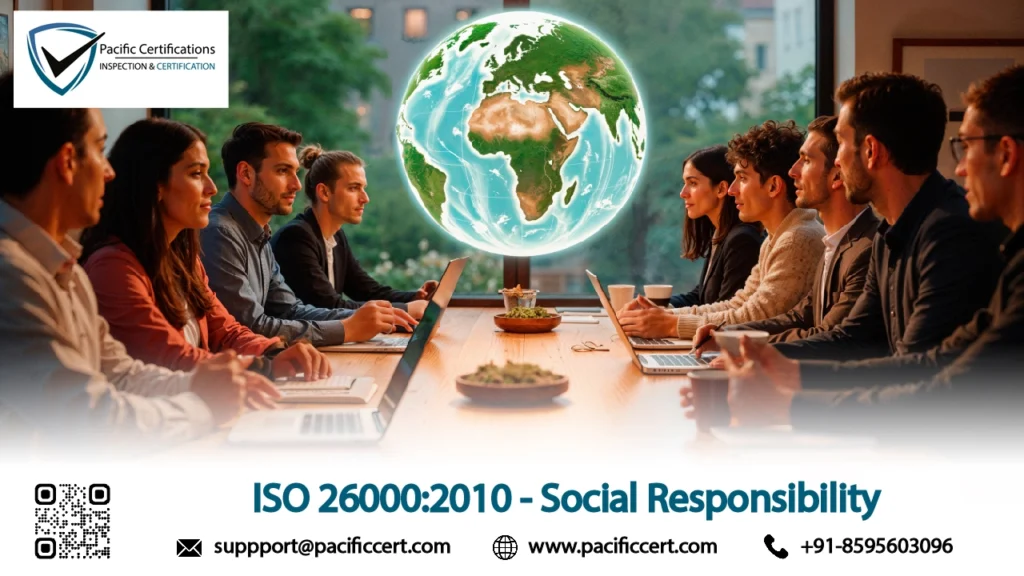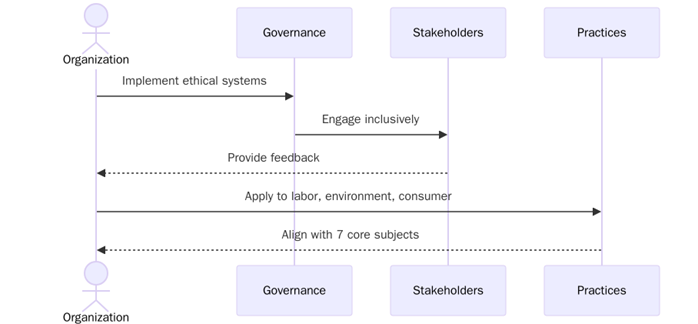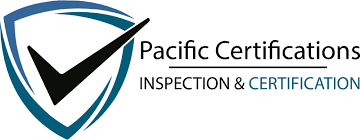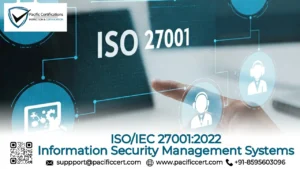What is ISO 26000?

ISO 26000 is an international standard that provides guidance on social responsibility (SR) and sustainable development. ISO 26000 provides guidance for implementing responsible business practices in a way that has a positive impact on society and the environment. The standard has seven main topics where the organization should consider social responsibility: organizational governance, human rights, labour practices, the environment, fair operating practices, consumer issues, and community involvement and development. When an organization adopts the guidelines of ISO 26000 the organization takes a longer-term position of being socially responsible with a commitment to ethical behaviour, sustainability, and making a positive difference for society.
ISO 26000:2010 acts as a springboard for organizations to formulate policies and practices founded on a deeper stance of social and environmental responsibility beyond legal compliance, and that ultimately add value to the company and the community in which it operates.
For more information, contact us at support@pacificcert.com.
Purpose
ISO 26000:2016 aims to provide organizations with an overarching framework for thinking about and implementing social responsibility (SR). ISO 26000 guides organizations about the societal and environmental impacts of their operations and promotes the legal, ethical, and social values of decision making and principles for sustainable development. ISO 26000 treats social responsibility as an ongoing commitment to improving an organization’s overall impact on society and creating transparency and positive reputational value amongst stakeholders, including customers, investors and communities.
Scope and Applicability
ISO 26000 applies to organizations of all types, regardless of industry, size, and geographical location. The standard includes guidance that is relevant to wide-ranging sectors from small businesses to large multinational companies. This standard is for organizations wishing to develop and promote socially responsible practices for their operations. It can be applied by governmental, private, and non-governmental organizations to support the development of sustainability and demonstrate good ethical stewardship. ISO 26000:2010 is used significantly in industries from manufacturing, energy, agriculture, finance, healthcare, and more, thus, it is key for any organization that wants to align its operations and practices towards global sustainability objectives and community expectations.
Key Definitions
- Social Responsibility (SR): The responsibility of an organization for the impacts of its decisions and activities on society and the environment, through transparent and ethical behavior that contributes to sustainable development.
- Sustainable Development: Development that meets the needs of the present without compromising the ability of future generations to meet their own needs.
- Stakeholders: Individuals or groups who have an interest in the organization’s activities and decisions, including employees, customers, suppliers, investors, and communities.
- Corporate Social Responsibility (CSR): A broader concept encompassing an organization’s efforts to manage the social, environmental, and economic impacts of its operations.
ISO 26000 Clause-wise structure
Clause Number | Title | Description |
Clause 1 | Scope | Defines the scope of the standard, focusing on the guidelines for social responsibility. |
Clause 2 | Normative References | Lists any other documents and standards referenced in ISO 26000. |
Clause 3 | Terms and Definitions | Provides clear definitions for key terms used in the standard. |
Clause 4 | Principles of Social Responsibility | Describes the principles that guide organizations in implementing social responsibility practices. |
Clause 5 | The Organizational Context | Explains the importance of organizational governance, leadership, and structure in integrating social responsibility into business practices. |
Clause 6 | Core Subjects of Social Responsibility | Details the seven core subjects: governance, human rights, labor practices, the environment, fair operating practices, consumer issues, and community involvement. |
Clause 7 | Integrating Social Responsibility into the Organization | Provides guidance on how to integrate SR into an organization’s policies and operations. |
Clause 8 | Communication on Social Responsibility | Outlines the importance of transparent communication with stakeholders regarding SR efforts. |
Clause 9 | Monitoring, Review, and Improvement | Encourages organizations to continuously evaluate and improve their SR practices. |
What are the requirements of ISO 26000?
ISO 26000 requires organizations to adopt a holistic approach to social responsibility, incorporating sustainable practices and ethical decision-making into their business strategies. The following are key requirements:

- Organizations must adopt strong governance practices, ensuring transparency, ethical behavior, and accountability in decision-making.
- Organizations must respect and promote human rights, ensuring fair treatment, equal opportunity, and non-discrimination in the workplace and supply chain.
- It is essential to provide fair labour practices, ensuring safe working conditions, fair wages, and respect for employee rights.
- Organizations must minimize their environmental footprint through sustainable practices, such as reducing waste, conserving energy, and minimizing pollution.
- This includes promoting fair competition, anti-corruption practices, and respecting intellectual property rights in business dealings.
- Organizations must ensure that products and services meet the needs and expectations of customers, ensuring safety, fairness, and transparency in product offerings.
- Engaging with local communities to support social, economic, and environmental well-being and contribute to community development.
For more information, contact us at support@pacificcert.com.
ISO 26000 Certification: Documentation Checklist
The audit checklist for ISO 26000 certification includes the following:
- Has the organization integrated ethical, transparent, and accountable governance into all levels of decision-making and stakeholder engagement?
- Are stakeholder interests identified, prioritized, and incorporated into the organization’s strategies, communication, and social responsibility initiatives?
- How does the organization assess and mitigate its human rights impacts across operations, including issues of discrimination, vulnerable groups, and supply chain risks?
- Are fair labor practices ensured, including safe working conditions, fair wages, no forced or child labor, and the right to collective bargaining?
- Is environmental responsibility embedded into operations through impact assessments, resource efficiency, pollution control, and climate change mitigation?
- Does the organization enforce fair operating practices, including anti-corruption measures, ethical conduct, and responsible supplier relationships?
- Are consumer rights protected through product safety, transparent information, complaint handling, data privacy, and responsible marketing?
- Does the organization engage in meaningful community involvement and development, including education, employment, and support for local initiatives?
- Are social responsibility objectives documented, measured, reviewed, and supported by staff training, performance tracking, and continual improvement mechanisms?
What are the benefits of ISO 26000?
ISO 26000 certification helps organizations demonstrate their commitment to ethical practices and social responsibility, which upgrades their reputation and trust with stakeholders. Below are some of the key benefits of obtaining ISO 26000 certification:

- Certification upgrades the organization’s reputation by demonstrating a commitment to ethical and sustainable practices.
- Organizations that adopt social responsibility practices are viewed more favourably by customers, leading to improved customer loyalty.
- Certification helps organizations differentiate themselves in the market by showcasing their commitment to sustainability and responsible practices.
- Achieving certification helps organizations meet legal and regulatory requirements related to environmental protection, human rights, and labour practices.
As sustainability and corporate social responsibility become increasingly important to consumers, regulators, and investors, the demand for ISO 26000 certification is expected to grow significantly in the recent years. The shift towards a more socially responsible business model will further drive the need for ISO 26000 certification as a benchmark for corporate integrity and sustainability.
Emerging Trends in Social Responsibility
In addition to adopting new technologies, organizations are also focusing on other emerging trends in social responsibility. Climate Action as the companies are increasingly adopting carbon reduction strategies and investing in renewable energy as part of their sustainability goals. Diversity and Inclusion which helps in Ensuring diversity in the workplace and addressing social issues related to race and culture are becoming critical areas for organizations to focus on. Circular Economy helps Businesses are shifting towards a circular economy model, where resources are reused and waste is minimized, supporting long-term sustainability.
New Technologies in Social Responsibility
Organizations that adopt ISO 26000 can leverage emerging technologies to enhance their social responsibility efforts. These innovations help companies monitor their environmental impact, engage more effectively with stakeholders, and streamline supply chain transparency. Some of these technologies include:
Blockchain: Used to increase supply chain transparency and ensure ethical sourcing of materials.
Data Analytics: Helps organizations measure and track the effectiveness of their social responsibility initiatives and report data to stakeholders.
Artificial Intelligence (AI): Used for automating sustainability efforts, such as optimizing energy consumption or managing waste.
Incorporating these technologies helps organizations stay ahead of regulatory changes and industry expectations, further cementing their commitment to corporate social responsibility.
ISO 26000 Certification Process
The certification process for ISO 26000 includes the following steps:
- Pre-Certification Assessment: Conducting a gap analysis to assess the organization’s current SR practices and identify areas for improvement.
- Documentation Review: Reviewing existing policies, procedures, and documentation to ensure compliance with ISO 26000 requirements.
- Stage 1 Audit: A preliminary audit to assess readiness and identify any areas where SR practices need to be strengthened.
- Stage 2 Audit: A detailed on-site audit to evaluate the implementation of SR practices and assess the organization’s overall approach to social responsibility.
- Certification Decision: Certification is awarded once the organization demonstrates full compliance with ISO 26000.
- Ongoing Monitoring: Regular surveillance audits ensure that the organization continues to meet the SR guidelines outlined in ISO 26000.
Timeline for ISO 26000 Certification
The timeline for ISO 26000 certification generally spans several months. The pre-assessment and preparation phase takes 1-2 months, during which the organization reviews its current SR practices. The Stage 1 audit lasts about 1 month, focusing on readiness and documentation review. The Stage 2 audit, which involves a more overreaching review, takes 1-2 months. Certification issuance happens within 3-6 months, depending on the audit findings and the organization’s readiness.
What is ISO 26000 Certification cost?
ISO 26000 Certification cost can vary depending on factors such as the size of the organization, the complexity of its operations, and the number of locations involved. The costs generally include:
Audit Fee is the Fee for the certification body’s audit process. Training costs are the costs for educating staff on ISO 26000 and the necessary processes for compliance. Ongoing maintenance are the costs for regular audits and recertification, required every 3 years.
How Pacific Certifications Can Help?
At Pacific Certifications, we provide overreaching auditing and certification services for ISO 26000. Our team will guide you through the entire certification process, ensuring that your organization meets the highest standards for social responsibility. Our services include:
- Stage 1 and Stage 2 audits to evaluate your SR practices.
- Objective conformity assessments based on ISO 26000.
- Certification issuance upon successful completion of the audit.
- Ongoing surveillance audits to ensure continued compliance.
- Support for multi-site or global operations.
For audits and certification, contact support@pacificcert.com.
ISO 26000 Training and Courses
Various training courses are available to help organizations comply with ISO 26000, including:
- Lead Auditor Training – Equips professionals to conduct external third-party audits.
- Lead Implementer Training – For those responsible for planning and executing ISO 26000 implementation.
- Internal Auditor Training – Preparing internal auditors for certification audits
Pacific Certifications provides accredited training programs. If your organization is looking for ISO 26000 training, our team is equipped to help you.
If you are looking for certification support or training for ISO 26000, contact us at support@pacificcert.com!
Frequently Asked Questions (FAQs)
Is ISO 26000 certification mandatory for all organizations?
While not legally required, ISO 26000 certification helps organizations improve their social responsibility practices and demonstrate their commitment to sustainability and ethical business practices.
What are the main benefits of ISO 26000 certification?
Certification ensures compliance with social responsibility standards, improves reputation, increases customer trust, and helps organizations meet regulatory requirements.
Can I apply for ISO 26000 certification without an SR management system in place?
No, organizations must have a social responsibility management system in place before applying for certification.
How often do I need to renew ISO 26000 certification?
ISO 26000 certification is valid for three years, after which recertification is required.
How long does it take to get ISO 26000 certification?
The certification process typically takes 3–6 months, depending on your organization’s preparedness and audit outcomes.
Where can I get support to implement ISO 26000?
You can contact consultants or certification bodies like Pacific Certifications for guidance and implementation support tailored to ISO 26000.
How to get ISO 20000 certification
Implement an SMS that meets ISO/IEC 20000-1, run internal audits and a management review, then engage an accredited certification body for a two-stage audit: Stage 1 (document/readiness review) and Stage 2 (implementation on site). After approval, maintain the certificate through annual surveillance.
What is the difference between ITIL and ISO 20000?
ITIL is a best-practice framework you adopt; organizations don’t get “ITIL certified.” ISO/IEC 20000-1 is a certifiable standard with mandatory requirements. Many teams use ITIL practices to help meet ISO 20000-1.
What is the latest version of ISO 20000?
The current edition is ISO/IEC 20000-1:2018, it was reviewed and confirmed in 2023. An Amendment 1 was published in February 2024.
Ready to get ISO 26000 certified?
Contact Pacific Certifications to begin your certification journey today!
Suggested Certifications –
Read more: Pacific Blogs






